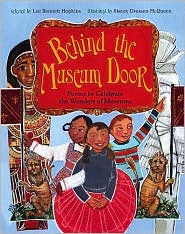 BIBLIOGRAPHY
BIBLIOGRAPHYHopkins, Lee Bennett. 2007. Behind the Museum Door: Poems to Celebrate the Wonders of Museums. Illus. by Stacey Dressen-McQueen. NY: Harry N. Abrams, Inc. ISBN: 9780810912045.
SUMMARY
Museums and the treasures they house are celebrated through a collection of poems.
CRITICAL ANALYSIS
In this fun collection, Lee Bennett Hopkins have selected fourteen poems written by poets of well-known fame like Jane Yolen, J. Patrick Lewis, and Kristine O’Connell George and other talented poets like Maria Fleming and Heidi Bee Roemer that brings the awe and wonder of museums and their artifacts to young readers. The majority of the poems are written in a rhyme like “O Trilobite” by Alice Schertle while some are free verse or abstract like Heidi Bee Roemer’s poem “Stirring Art” that describes a Calder mobile:
Beauty
suspended in
suspense.
A breath of air
awakens
lifeless form–
See
it
dance.
All of the poems are written in the viewpoint of children and their personal thoughts about the artifacts that they are viewing. Many express the wonderings and imagination of the children that are humorous as seen in the poem “To the Skeleton of a Dinosaur in the Museum”: “Hey there, Brontosaurus!/…/How were the good old days?/…/did you shake the earth like thunder/With your roars and groans?/I wonder….Say it’s hard/To have a conversation/With your bones.”
Other poems also share the child’s creative and even dramatic imagination of thinking of what the young girl who use to where the moccasins behind the glass case did while wearing those shoes and who now tiptoes “across the cold tile–open–/the glass display case–reclaim/her shoes.” and describing the great wooly mammoth is now “a ghost that haunts museum halls,/Ice Age icon, here enshrined,/once frozen in earth,/now frozen in time.”
Throughout the book, the poems have wonderful imagery that captures the essence of the artifact. This is especially seen in Beverly McLoughland’s “Suit of Armor”:
In its human shape
Of molded steel,
It looks as though
There’s someone real
Inside. You know:
“Hello in there,”
And hear a dull
Echo of air
As though a voice
Were drifting through
The lonely centuries
To you.
And in “Tales in Taspestry” by Sandra Gilbert Brüg, which also uses wonderful words to describe the art:
Tales of chivalry, cruelty, battles, bloodshed,
victory–heroes, heroines, kings
their fearsome deeds depicted
in exquisite woven scenes
Whose fingers held the bobbins?
Whose hands these fibers wed?
Or was it spiders, traced designs this fine
with silk and golden thread.
Sumptuous panels, huge…immense,
costly made for grand display;
centuries old–yet bold enough
to capture hearts today
Gaze long and deep at tapestries;
intensely human folk you’ll see
and by their kinship you can touch
the stream of all humanity.
Away Away–I bid you go
to feast upon the lasting glow
of fascinating tales that show
other lives in other time–
inside museum doors.
To compliment the poems Dressen-McQueen’s colorful illustrations fill the double-page spreads per poem in colorful folk art depicting the museum artifacts and art. The illustrations enhance the poems and provide images in how the artifacts and art depict moments in history as well as imaginations of their admirers. There is also attention to the multicultural details of the children that are seen throughout the book. They vary in all ethnicities, skin tones, hairstyles, and clothing, which expresses that everyone loves going to the museums.
Perfect to share before going on a museum field trip, on art or history lesson, or simply for pure enjoyment, Behind the Museum Door is a perfect addition to any library.
CONNECTIONS
*Read more poetry books about art and museums like Mrs. Brown on Exhibit and Other Museum Poems by Susan Katz and Illus. by R.W. Alley.
*Ask the students what was their favorite artifact or artwork that they saw when visiting a museum and why.
No comments:
Post a Comment
Thank you for visiting, WP-CC! Please leave a comment!